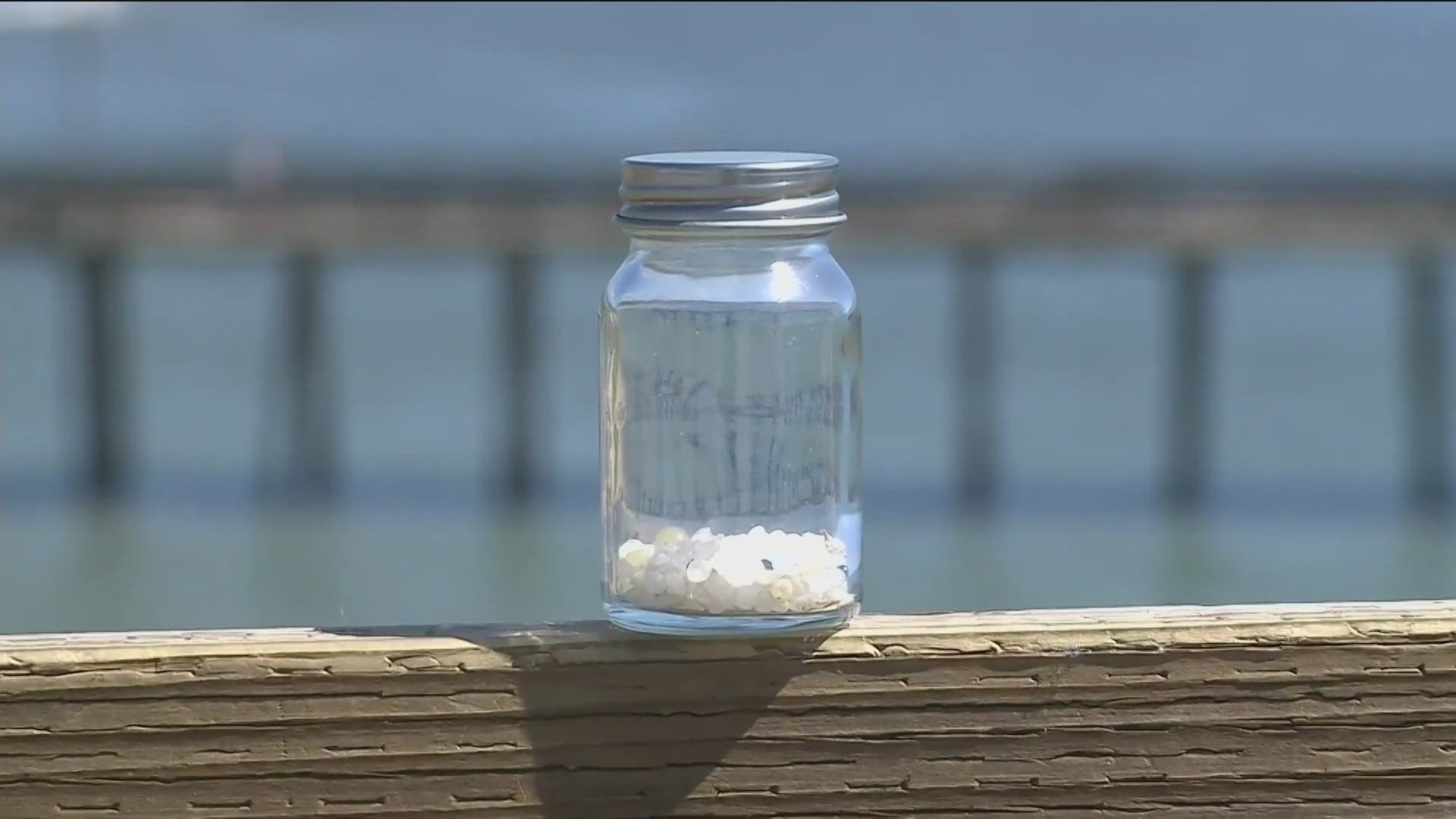SAN DIEGO — You might not know the name of them, but you've probably seen them. Plastic pellets called nurdles are often found mixed in with the sand at our local beaches. Sometimes you have to adjust your eyes to spot them amongst grains of sand and dirt. They might be tiny, but they're causing big problems in our ecosystem.
"It's the pre-production pellet of all plastic that is out there. So, manufacturers then melt these nurdles or pellets into every plastic product that you see out there from sunglasses to water bottles to your plastic beach toys," explained Clare Swithenbank-Bowman as we walked along the pathway near the railroad tracks in Encinitas.
Clare started Litter 4 Tokens in South Africa which has expanded to Trash 4 Tokens in North and South America to increase awareness about the harms of litter and plastic pollution, especially nurdles.
Nurdles come in a variety of different colors like gray, blue and white. There are seven different types as well. For example, a P6 nurdle is used to make Styrofoam, and they all have the same tiny shape.
They are transported across the global by the chemical industry to plastic manufacturers. Clare, who was already working to stop nurdles pollution in South Africa, found them at our local beaches, along with her son after moving to San Diego about 3 years ago. She estimates roughly trillions of these pellets have been found locally. On our short walk, we found a large number of them.
They are not just a local problem. Nurdles are found littering the landscape across the globe. Data collected from plastic waste organizations estimate up to 23 billion plastic nurdles are embedded in the environment per day in the European Union [EU]. An estimated 230 billion kilos, roughly 507 billion pounds, of plastic nurdles enter our seas and oceans annually.
"Fish mistake them for eggs or food and they clog up their systems. They starve and the marine life is eating them and dying and starving. Then we eat the fish. So they've entered into our food chain," explained Swithenbank-Bowman.
Clare has teamed up with Mark O'Connor, a lead on the Rise Above Plastics program for Surfrider San Diego County.
"It's just a nasty little plastic nugget that shouldn't be in the environment," exclaimed O'Connor.
He always thought nurdles were only polluting our beaches from offshore spills.
"They've located them in our own backyard. On the rail system, they're falling off. Rails go over lagoons, landing right in the water get out to the ocean. Roadways, right in the storm drains out in the water and where we are here, okay some probably rain and wind to get them in the storm drain out to the ocean," said O'Connor.
Surfrider Foundation is encouraging members and supporters to call and email their federal elected officials to support the Plastic Pellet Free Waters Act. It was presented by lawmakers including Congressman Mike Levin working to get this bill forwarded and passed. The United States Environmental Protection Agency [EPA] has to issue the final rule to prohibit the way plastic pellets are discharged so they don't make it into the waters of the United States.
These tiny pellets are highly toxic because they have hazardous chemicals attached to them. The size, plastic makeup and toxicity of these pellets are an environmental threat, even if they are disposed of in landfills.
Clare is actively working with the United Nations and International Maritime Organization to get all countries to amend the International Maritime Dangerous Goods Code, so nurdles are shipped below deck, in more secure containers and labeled as a hazardous material.
"If the actual amendment of the code doesn't happen, it'll continue to leak in these different areas. So, if we're not preventing, it'll still happen," said Swithenbank-Bowman.
The team at Trash 4 Tokens also encourages you to get involved in reducing nurdles in our county. Also known as Mermaid Tears, Clare created a Mermaid Tear Catcher.
"They're a unique device. They have a unique code on them. So, when you find the actual mermaid tears, you can log onto our website and log the geographic location, where you found those mermaid tears and you're entered to win amazing prizes," said Swithenbank-Bowman.
This frisbee is made from recycled plastic with holes designed to capture nurdles, Styrofoam and other microplastics. But remember...
"They're very toxic. So always wash your hands after you find the nurdles. Place them into jars or in envelopes. You can post them back to our foundation, but please don't put them back in the trash or in a recycling bin because they cannot be recycled," explained Swithenbank-Bowman.
Just one more way to keep our county's ecosystem, and our bodies, free of microplastics.

